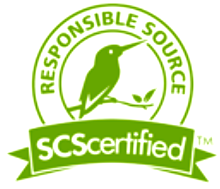
This post continues the series of posts about some of the more rarely see certification labels and accreditation.
In this post, I’ll be looking at the CSC Responsible Source standard, which aims very clearly at the issue of (un)ethical, (in)transparent supply chains. The standard exists for 2 very specific area of expertise: precious gems and metals; and man-made fibres and textiles.
According to the SCS’s website, there are plans to extend the Certified Responsible Source ecolabel standard to cover also natural fibers (specifically wool and cotton) and bioplastics.
Who is SCS, and what is the Responsible Source standard?
In general terms, the SCS Responsible Source standard makes sure that both metals, gems as well as fibres and resins for textile production meet a basic benchmark in terms of production, environmental, social and ethical accountability.
Reviewing the different activities of SCS as a company, it is evident that they are a commercial auditing company with proprietary standards – which, however, are publicly available via their website. Many of these are standards targeting specific national issues (e.g. a standard related to the Brazilian rain forest) related to sustainability.
SCS Responsible Source standard for Recycled Chip, Pellets, and Manufactured Fibers
This is a third-party recognition that aims at confirming that a company’s polyester fiber and resin have been produced in accordance with fundamental benchmarks of environmental, social and ethical accountability.
Who is it for?:
This standard is intended for recyclers, processors, and downstream manufacturers who use recycled polyethylene terephtalate (rPET).
Products to which the standard can be applied are: recycled polymer scrap, resin, pellets, and flake; fiber and spun fiber; as well as fabrics made from these materials.
The standard is based on the more general Recycled Content Standard, which audits manufacturing supply chains more generally about the use of pre- and post-consumer recyclable materials in production.
The Standard’s components
- Recycled Polymer Materials
- Ethical – Avoidance questionable or unethical sources
- Labor Protections – Insurance of workers’ fair treatment according to internationally recognized (ILO) labor standards
- Supply Chain Management – Introduction of supply chain risk management tools to improve sourcing strategies and prevent destructive environmental practices
- Environmental Impact Assessment – Examination of environmental impacts associated with product manufacturing
SCS Responsible Source standard for Precious Metals, Gemstones and Jewellery
This is a third-party recognition that aims at building confidence in precious metals, gemstones and jewellery by highlighting industry leadership on the path to sustainability. It hence is intended to assure customers that recycled metals and gemstones are used, and conflict metals and materials from questionable or illegal sources actively avoided.
Beyond that, it also intended for companies to be able and demonstrate that fundamental benchmarks of social and environmental accountability, including risk management throughout the supply chain are met, that workers are treated fairly according to international labor standards, and that destructive environmental practices are avoided.
Who is it for?
This standard is intended for the entire supply chain from refiners and manufacturers to fabricators, jewellers and retailers. Product categories include fine metals, alloyed metals, gemstones, findings and jewellery.
This specific standard is available online in full detail, explaining the different deliverables and compliance issues that need to be adhered to: <href=”http: www.scsglobalservices.com=”” files=”” standards=”” scs_stn_responsiblesource_v1-0.pdf”=”” title=”Responsible Source for Precious Metals Standard” target=”_blank”>Responsible Source for Precious Metals Standard.</href=”http:>
The Standard’s components
- Recycled Metals, Gemstones and Jewelry – Derivation from recycled sources
- Conflict-Free – Avoidance of conflict metals, gemstones and materials from questionable and illegal sources
- Labor Protections – Insurance of workers’ fair treatment in accordance to internationally recognized labor standards
- Supply Chain Management – IntIntroduciton of supply chain risk management tools to improve sourcing strategies and prevent destructive environmental practices
- Environmental Performance – Establishment of basic environmental performance standards and provides a clear pathway for continuing improvement over time
Conclusion
The SCS Responsible Source standard is a good introductory step for companies that have a clear strategy in place towards risk management and transparency in their supply chain.
Given the complex issues around conflict metals and minerals, as well as the transparency issues surrounding recyclables in the polyester supply chain such a standard has a very clear commercial value.
The fact that the certification criteria are available and published online makes a crucial difference to the discussion, as it allows for a clear-cut analysis of what the standard does, or does not, deliver on.
It must however not be ignored that many of the applied benchmarks and requirements are, overall, very basic. ILO labour criteria are by no means demanding when applied – although, clearly, they remain valuable as many supply chain members keep ignoring them as basic as they may be.
In a similar vain the requirements with regards to environmental compliance are basic at best.
However, the fact that there is an attempt at requiring transparency and traceability in the supply chain of these materials is important – the lack of these is clearly the beginning of all other non-compliance cases, and a constructive approach such as this to address them will help companies dealing with their internal supply chain challenges in a structured, pro-active and outcome-oriented way.
Video: Conflict Minerals: UC Davis Graduate School of Management Professor Paul Griffin and MBA students

